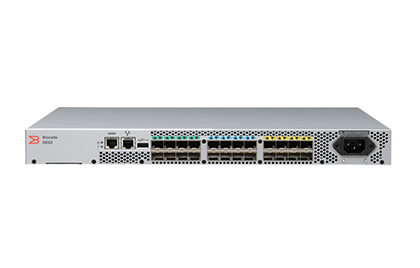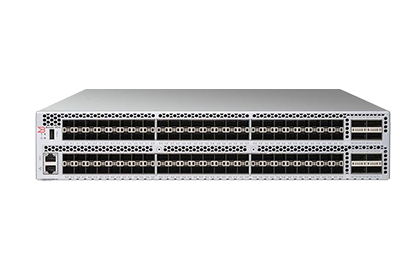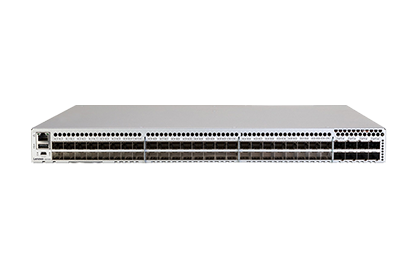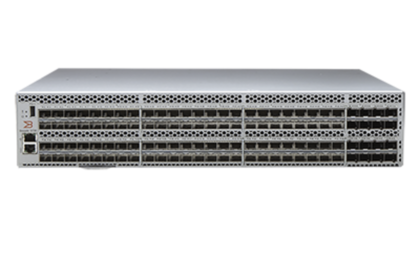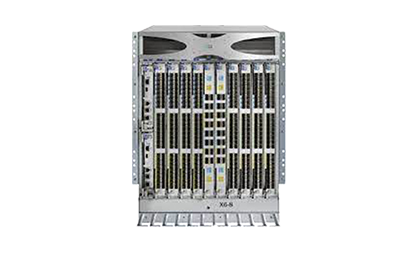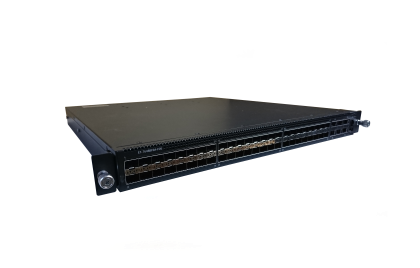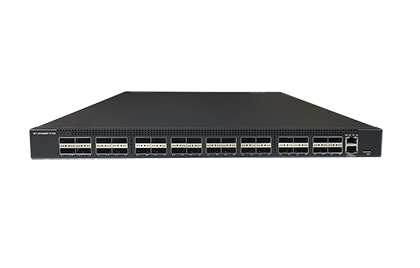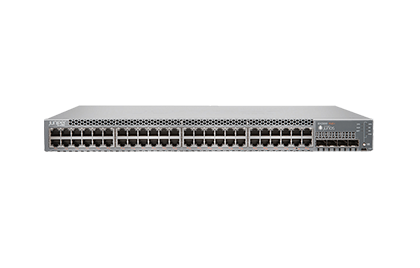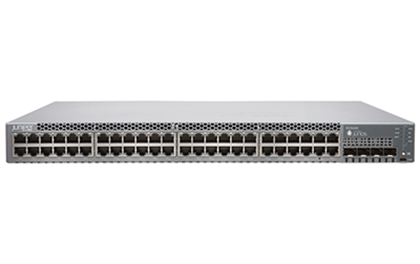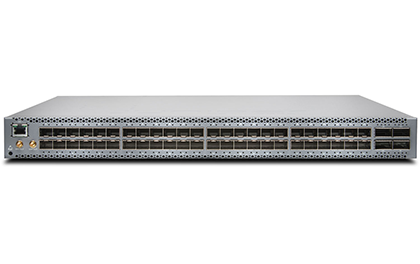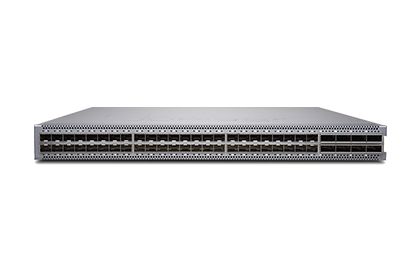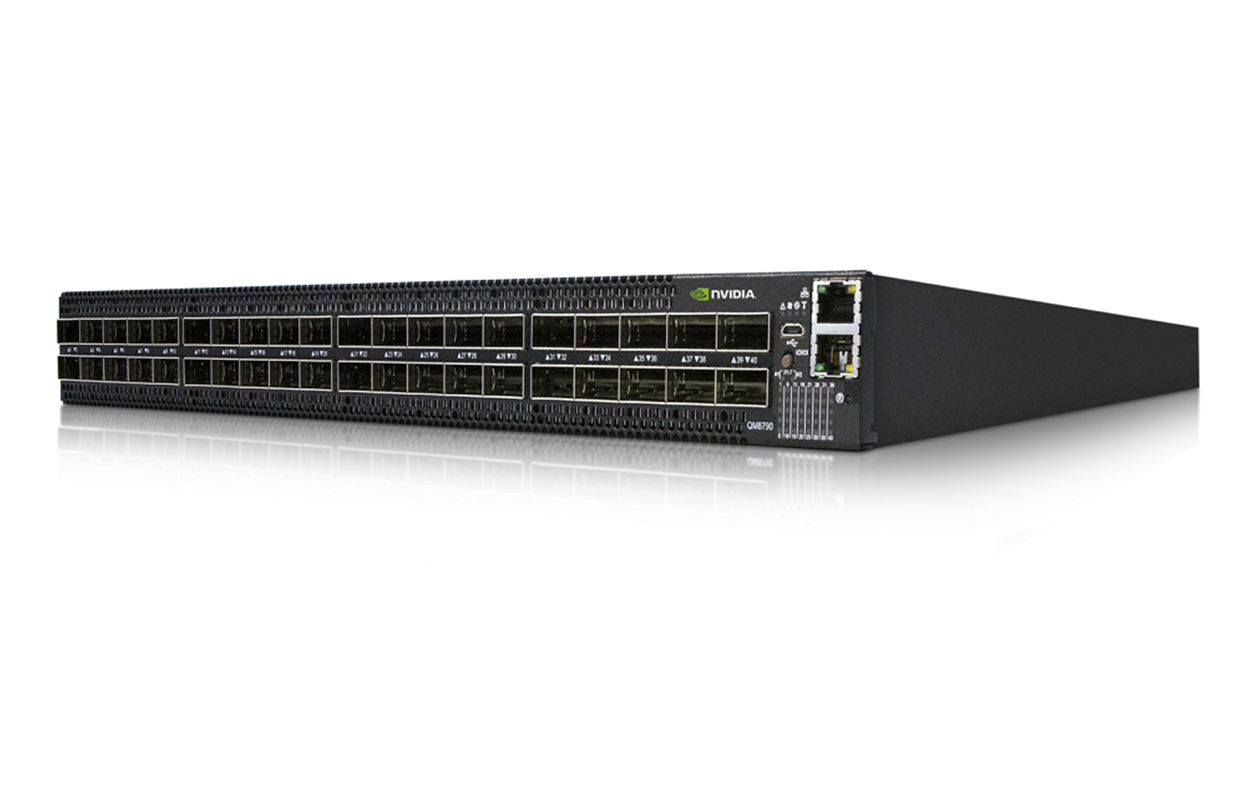For your edge-core-cloud scenarios
Networking solutions

Fujitsu hat eine Reihe von Top-of-Rack-Switches entwickelt, die flexible und effiziente Scale-out-Serverinfrastrukturen unterstützen, vor allem in Kombination mit neuen modularen Servern. Diese Vorgehensweise hat verschiedene Verbesserungen zur Folge, einschließlich Infrastruktureffizienz für Cloud Computing, eine durchgängige Virtualisierung und Konsolidierung von Ende zu Ende. Enge Partnerschaften mit Netzwerktechnologiepartnern ergänzen das Portfolio für den Aufbau kompletter IT-Infrastrukturen. Storage Area Networks (SANs) werden auch im nächsten Investitionszyklus die Grundlage des Rechenzentrumsnetzwerks darstellen, müssen jedoch hinsichtlich der Bandbreite und der Verwaltungsfunktionen verbessert werden. Hierzu arbeitet Fujitsu mit Broadcom zusammen, das kürzlich Brocade, den führenden Anbieter von SAN-Switches, übernommen hat. Viele neue Anwendungsfälle basieren auf Ethernet-Netzwerken mit Bandbreiten von bis zu 100 Gbit und zunehmend virtualisierten Fabric-Architekturen für den Aufbau dynamischer Rechenzentren. Fujitsu arbeitet auch mit Extreme Networks zusammen, das die führenden leistungsstarken IP-Netzwerk-Switches anbietet. Und es versteht sich von selbst, dass die Server- und Storage-Systeme von Fujitsu vollständig mit Produkten aller wichtigen Netzwerk-Switch-Anbieter, einschließlich Cisco, kompatibel sind.
Transform your network with the right switches
Vendor
Product type
Network speed
Number of ports (max.)
Media type
| Brocade G610 | Brocade G630 | Brocade G720 | Brocade G730 | Brocade X7 Directors | Fujitsu PSWITCH 2048 | FUJITSU PSWITCH 4032P | Juniper EX2300 | Juniper EX3400 | Juniper QFX5110 | Juniper QFX5120 | NVIDIA InfiniBand-Switch, 40 Ports, 200 Gb/s | |
|---|---|---|---|---|---|---|---|---|---|---|---|---|
| Fibre-Channel-Leistung | Fibre Channel: 4,25 Gbit/s Leitungsgeschwindigkeit, Vollduplex, 8,5 Gbit/s Leitungsgeschwindigkeit, Vollduplex, 14,025 Gbit/s Leitungsgeschwindigkeit, Vollduplex, Auto-Sensing der Port-Geschwindigkeiten 4 Gbit/s, 8 Gbit/s, 16 Gbit/s und 32 Gbit/s | Fibre Channel: 4,25 Gbit/s Leitungsgeschwindigkeit, Vollduplex, 8,5 Gbit/s Leitungsgeschwindigkeit, Vollduplex, 10,53 Gbit/s Leitungsgeschwindigkeit, Vollduplex, 14,025 Gbit/s Leitungsgeschwindigkeit, Vollduplex, 28,05 Gbit/s, Vollduplex, 112,2 Gbit/s, Vollduplex, Auto-Sensing der Port-Geschwindigkeiten 4/8/10/16/32 Gbit/s und Unterstützung von Geschwindigkeiten bis zu 128 Gbit/s, 10 Gbit/s optional programmierbar auf feste Port-Geschwindigkeit. Auto-Sensing der Geschwindigkeiten 4×32 / 4×16 / 4×8 / 4×4 Gbit/s an den QSFP-Ports mit Brocade FOS v8.2.0. |
Fibre Channel: 8,5 Gbit/s Leitungsgeschwindigkeit, Vollduplex, 10,53 Gbit/s Leitungsgeschwindigkeit, Vollduplex, 14,025 Gbit/s Leitungsgeschwindigkeit, Vollduplex, 28,05 Gbit/s Leitungsgeschwindigkeit, Vollduplex, 57,8 Gbit/s Leitungsgeschwindigkeit, Vollduplex, Auto-Sensing der Port-Geschwindigkeiten 8, 10, 16, 32 und 64 Gbit/s. 10 Gbit/s [1] optional programmierbar auf feste Port-Geschwindigkeit. [1] nur in Europa, dem Nahen Osten & Afrika verfügbar |
Fibre Channel: 8,5 Gbit/s Leitungsgeschwindigkeit, Vollduplex, 10,53 Gbit/s Leitungsgeschwindigkeit, Vollduplex, 14,025 Gbit/s Leitungsgeschwindigkeit, Vollduplex, 28,05 Gbit/s Leitungsgeschwindigkeit, Vollduplex, 57,8 Gbit/s Leitungsgeschwindigkeit, Vollduplex, Auto-Sensing der Port-Geschwindigkeiten 8, 10, 16, 32 und 64G. 10G[1] optional programmierbar auf feste Port-Geschwindigkeit. [1] 10G ist nur in Europa, dem Nahen Osten & Afrika verfügbar |
- | - | - | - | - | - | - | - |
| Fibre Channel-Ports |
Switch-Modus (standardmäßig): Konfigurationen mit 8, 16 und 24 Ports (Schritte á 8 Ports über „Ports on Demand [PoD]“-Lizenz), E_Ports, F_Ports, M_Ports und D_Ports Brocade Access Gateway mit standardmäßigem Port-Mapping: 40 SFP+ F_Ports, 8 SFP+ N_Ports |
96 SFP+ Ports , die mit Fibre Channel Auto-Sensing-Geschwindigkeiten von 4/8/10/16/32 Gbit/s betrieben werden können, 8 QSFP-Ports, die mit Fibre-Channel-Geschwindigkeiten von 4×32 / 4×16 / 4×8 / 4×4 Gbit/s betrieben werden können. Bietet eine Basiskonfiguration von 48 Ports, zwei 24-Port SFP+ PoD (Ports on Demand) und einem 32-Port QSFP PoD. Der Switch verfügt insgesamt über acht 32 Gbit/s QSPF-Ports. So können Nutzer*innen von 48 Ports auf bis zu 128 Ports erweitern. Unterstützt F/E/EX_Port- und D_Port-Typen an den SFP+Ports und ausschließlich F/E/EX_Port- und D_Port-Typen an den QSFP-Ports mit Brocade Fabric OS® (FOS) v8.2.0. |
Switch-Modus (standardmäßig): Minimum von 24 Ports und Maximum von 56 Ports. Ports werden in Schritten von 8 Ports auf bis zu 56 Ports über „Ports on Demand (PoD)“-Lizenzen aktiviert, E_Ports, F_Ports, M_Port, D_Ports, EX_Ports. Brocade Access Gateway mit standardmäßigem Port-Mapping: 56 SFP+ F_Ports, 8 SFP+ N_Ports. |
128 Ports (96 x 64G SFP+ Ports, plus 16 x 2 x 64G SFP-DD Ports), von denen jeder E_Ports, F_Ports,M_Ports, D_Ports, und EX_Ports unterstützt. Basiskonfiguration von 48 Ports, zusätzliche Ports werden mit zwei 24-Port SFP+ POD (Ports on Demand) und einem 32-Port SFP-DD POD (16 x 2 x 64G SFP-DD-Transceiver) aktiviert, wodurch der Switch von 48 Ports auf 128 Ports skaliert wird. |
CR64-8 und CR64-4 CR Blades: E_Port, EX_Port und D_Port. FC32-X7-48, FC64-48 Port Blades: F_Port, E_Port, EX_Port, M_Port, SIM und D_Port. Die Selbsterkennung basiert auf dem Switch-Typ (U_Port) und der optionalen Kontrolle des Port-Typs. |
- | - | - | - | - | - | - |
| Maximale Fabric-Latenz | Die Latenz für lokal geschaltete Ports beträgt 900 ns (einschl. FEC) | - | Die Latenz für lokal geschaltete Ports beträgt 460 ns (einschl. FEC) | Die Latenz für lokal geschaltete Ports beträgt 460 ns (einschl. FEC) | - | - | - | - | - | - | - | - |
| Skalierbarkeit | Komplette Fabric-Architektur mit maximal 239 Switches | Komplette Fabric-Architektur mit maximal 239 Switches | Komplette Fabric-Architektur mit maximal 239 Switches | Komplette Fabric-Architektur mit maximal 239 Switches | Vollständige Fabric-Architektur mit 239 Switches. | - | - | - | - | - | - | - |
| Maximal | 9000 aktive Knoten, 56 Switches, 19 Hops in Brocade Fabric OS® Fabrics, größere Fabrics nach Bedarf |
Einzelne Fabric: 56 Domains, 7 Hops MPR-Fabric: 19 Hops |
4000 aktive Knoten, 56 Switches, 19 Hops in Brocade Fabric OS® Fabrics | 4000 aktive Knoten, 56 Switches, 19 Hops in Brocade Fabric OS® Fabrics | 6000 aktive Geräte pro Switch, 56 Switches, 19 Hops in Brocade Fabric OS® (FOS) Fabrics, größere Fabrics nach Bedarf. | - | - | - | - | - | - | - |
| ISL-Trunking |
Frame-basiertes Trunking mit bis zu acht 32-Gbit/s-Ports pro ISL-Trunk, bis zu 256 Gbit/s pro ISL-Trunk Exchange-basierter Lastausgleich über ISLs mit DPS in Brocade Fabric OS integriert. |
Frame-basiertes Trunking mit bis zu acht 32 Gbit/s Verbindungen zwischen einem Switch-Paar, kombiniert, um einen einzigen logischen ISL mit einer Geschwindigkeit von bis zu 256 Gbit/s (512 Gbit/s Vollduplex) pro ISL-Trunk zu bilden. Exchange-basierter Lastausgleich über ISLs mit DPS in Brocade FOS integriert. An den QSFP-Ports werden 256 Gbit/s Trunks durch Trunking von 2× (4×32 Gbit/s) QSFP-Ports unterstützt. | Frame-basiertes Trunking mit bis zu acht 16 Gbit/s Ports pro ISL-Trunk, bis zu 128 Gbit/s pro ISL-Trunk. Exchange-basierter Lastausgleich über ISLs mit Dynamic Path Selection (DPS) in Brocade Fabric OS integriert. | Frame-basiertes Trunking mit bis zu acht 16 Gbit/s Ports pro ISL-Trunk, bis zu 128 Gbit/s pro ISL-Trunk. Exchange-basierter Lastausgleich über ISLs mit Dynamic Path Selection (DPS) in Brocade Fabric OS integriert. | Frame-basiertes Trunking mit bis zu acht 64-Gbit/s-Ports pro ISL-Trunk, bis zu 256 Gbit/s pro ISL-Trunk, Exchange-basierter Lastausgleich über ISLs mit DPS in Brocade FOS integriert | - | - | - | - | - | - | - |
| Gesamtbandbreite | 768 Gbit/s durchgängiges Vollduplex | 4 Tbit/s | 3,584 Tbit/s | 8,192 Tb/s | - | - | - | - | - | - | - | - |
| Maximale Rahmengröße | 2112 Byte Nutzlast | 2112 Byte Nutzlast | 2112 Byte Nutzlast | 2112 Byte Nutzlast | 2112 Byte Nutzlast. | - | - | - | - | - | - | - |
| Rahmenpuffer | 2.000 dynamisch zugewiesen | 15000 Frame-Puffer mit der Möglichkeit zur dynamischen Pufferaufteilung zwischen Ports | 24000 pro schaltendem ASIC | 2K pro schaltendem ASIC | 24.000 pro schaltendem ASIC. | - | - | - | - | - | - | - |
| Serviceklassen | Klasse 2, Klasse 3, Klasse F (Inter-Switch-Frames) | Klasse 2, Klasse 3, Klasse F (Inter-Switch-Frames) | Klasse 2, Klasse 3, Klasse F (Inter-Switch-Frames) | Klasse 2, Klasse 3, Klasse F (Inter-Switch-Frames) | Klasse 2, Klasse 3, Klasse F (Inter-Switch-Frames). | - | - | - | - | - | - | - |
| Port-Typen |
F_Port, E_Port, M_Port, D_Port (ClearLink Diagnose-Port) an 24 SFP+ Ports Brocade Access Gateway-Modus: F_Port und NPIV-fähiger N_Port |
D_Port (ClearLink Diagnose-Port), E_Port, EX_Port, F_Port, AE_Port, optionale Kontrolle des Port-Typs | D_Port (ClearLink® Diagnose-Port), E_Port, EX_Port, F_Port, M Port, optionale Kontrolle des Port-Typs, Brocade Access Gateway-Modus: F_Port und NPIV-fähiger N_Port | D_Port (ClearLink® Diagnose-Port), E_Port, EX_Port, F_Port, M_Port, optionale Kontrolle des Port-Typs | - | - | - |
Bis zu 24 x 1-GbE- und 4 SFP/SFP+ 10-GbE-Uplinks. Ideal für Anwendungsfälle in Unternehmens-, Medien- und Rundfunknetzwerken, die immer noch ursprüngliche 1G/10G Base-T Kupferverbindungen erfordern. |
Bis zu 48 x 1-GbE- und 4 SFP/SFP+ 10-GbE- und 2 QSFP+ 40-GbE-Uplinks. Ideal für Anwendungsfälle in Unternehmens-, Medien- und Rundfunknetzwerken, die immer noch ursprüngliche 1G/10G Base-T Kupferverbindungen erfordern. |
- | - | - |
| Arten des Datenverkehrs | Fabric-Switches, die Unicast unterstützen | Fabric-Switches, die Unicast unterstützen | Fabric-Switches, die Unicast unterstützen | Fabric-Switches, die Unicast unterstützen | Fabric-Switches, die Unicast, Multicast (255 Gruppen) und Broadcast unterstützen | - | - | - | - | - | - | - |
| Medientypen |
32 Gbit/s: Brocade G610 erfordert Brocade hot-plug-fähigen SFP+, einen LC-Stecker, 32 Gbit/s SWL, LWL 16 Gbit/s: Brocade G610 erfordert Brocade hot-plug-fähigen SFP+, einen LC-Stecker, 16 Gbit/s SWL, LWL, ELWL Die Fibre-Channel-Entfernung ist abhängig vom eingesetzten Glasfaserkabel und der Port-Geschwindigkeit |
Hot-plug-fähiger, branchenüblicher Small Form-Factor Pluggable Plus (SFP+), LC-Stecker, Kurzwellenlaser (SWL), Langwellenlaser (LWL), erweiterter Langwellenlaser (ELWL), die Entfernung hängt vom Lichtwellenleiter und der Port-Geschwindigkeit ab. Unterstützt optische SFP+ (32/16/8 Gbit/s), SFP+ (16/8/4 Gbit/s), SFP+ 10 Gbit/s Transceiver, optische 4×32 Gbit/s QSFP SWL- und 4×16 Gbit/s QSFP SWL-Transceiver. Hinweis: 32 Gbit/s ELWL wird derzeit nicht mit Brocade FOS v8.2.0 unterstützt, ist aber für die Zukunft geplant. |
64 Gbit/s: Brocade G720 erfordert Brocade hot-plug-fähigen SFP+, einen LC-Stecker, 64 Gbit/s SWL. 32 Gbit/s: Brocade G720 erfordert Brocade hot-plug-fähigen SFP+, einen LC-Stecker, 32 Gbit/s SWL, LWL 10 km. 10 Gbit/s [1]: Brocade G720 erfordert Brocade hot-plug-fähigen SFP+, einen LC-Stecker, 10 Gbit/s SWL, LWL 10 km. Die Fibre-Channel-Entfernung ist abhängig vom eingesetzten Glasfaserkabel und der Port-Geschwindigkeit. [1] nur in Europa, dem Nahen Osten & Afrika verfügbar |
64G FC SFP+ LC-Anschluss: SWL 32G FC SFP+ LC-Anschluss: SWL, LWL, ELWL[1] 10G[2] FC SFP+ LC-Anschluss: SWL, LWL 2 x 64G FC SFP-DD SN-Anschluss: SWL [1] Das ELWL-Modul ist nur in Europa, dem Nahen Osten & Afrika verfügbar [2] 10G ist nur in Europa, dem Nahen Osten & Afrika verfügbar |
Brocade FC64-48 Port Blade: Unterstützt hot-plug-fähigen Brocade Fibre Channel SFP+ mit 8/10/16/32 Gbit/s SWL/LWL/ELWL und 64 Gbit/s SWL. Brocade FC32-X7-48 Port Blade: Unterstützt hot-plug-fähigen Brocade Fibre Channel SFP+ mit 4/8/10/16/32 Gbit/s SWL/LWL/ELWL. (F_Port-Konnektivität nur bei Verbindungsgeschwindigkeit von 4 Gbit/s.) Core Routing (CR) Blades, Brocade CR64-4 und CR64-8: Unterstützen hot-plug-fähigen Brocade Fibre Channel Gen 7 SWL QSFP, 4×32 Gbit/s SWL QSFP und 4×32 Gbit/s QSFP für ICL-Verbindungen. |
- | - | - | - | - | - | - |
| USB | Ein USB-Anschluss für den Download von System-Protokolldateien oder Firmware-Upgrades | Ein USB-Anschluss für den Download von System-Protokolldateien oder Firmware-Upgrades | Ein Standard-USB-Anschluss für Firmware-Download, Support-Speicherung und Konfigurations-Upload oder -Download. | Ein Standard-USB-Anschluss für Firmware-Download, SupportSave und Konfigurations-Upload oder -Download. | Ein USB-Anschluss pro Steuerprozessor für Firmware-Download, Support-Speicherung und Konfigurations-Upload oder -Download. | - | - | - | - | - | - | - |
| Fabric-Services | Monitoring and Alerting Policy Suite (MAPS), Flow Vision, Brocade Adaptive Networking (Isolation von Datenströmen, QoS), Fabric Performance Impact (FPI) Monitoring, Slow Drain Device Quarantine (SDDQ), Brocade Advanced Zoning (Standard-Zoning, Port/WWN-Zoning, Broadcast-Zoning, Peer-Zoning, Target-driven Zoning), Dynamic Fabric Provisioning (DFP), Dynamic Path Selection (DPS), Brocade Extended Fabrics, Enhanced BB Credit Recovery, FDMI, Frame-Weiterleitung, Frame-basiertes Trunking, FSPF, Brocade ISL Trunking, Management Server, NPIV, NTP v3, Registered State Change Notification (RSCN), Reliable Commit Service (RCS), Simple Name Server (SNS), Read Diagnostics Parameter (RDP), VM Insight | Monitoring and Alerting Policy Suite (MAPS), Flow Vision, Brocade Adaptive Networking (Eingangsratenbegrenzung, Isolation von Datenströmen, QoS), Fabric Performance Impact (FPI) Monitoring, Slow Drain Device Quarantine (SDDQ), Brocade Advanced Zoning (Standard-Zoning, Port/WWN-Zoning, Broadcast-Zoning, Peer-Zoning, Target-driven Zoning), Dynamic Path Selection (DPS), Brocade Extended Fabrics, Enhanced BB Credit Recovery, FDMI, Frame-Weiterleitung, Frame-basiertes Trunking, FSPF, Integrated Routing, Brocade ISL Trunking, Management Server, NPIV, Time Server, Registered State Change Notification (RSCN), Reliable Commit Service (RCS), Simple Name Server (SNS), Virtual Fabrics (Logical Switch, Logical Fabric), Read Diagnostics Parameter (RDP) | Fabric Vision, Monitoring and Alerting Policy Suite (MAPS), Flow Vision, Brocade Adaptive Networking (QoS), Fabric Performance Impact (FPI) Monitoring, Slow Drain Device Quarantine (SDDQ), Brocade Advanced Zoning (Standard-Zoning, Port/WWN-Zoning, Broadcast-Zoning, Peer-Zoning, Target-driven Zoning), Dynamic Fabric Provisioning (DFP), Dynamic Path Selection (DPS), Brocade Extended Fabrics, Enhanced BB Credit Recovery, FDMI, Frame-Weiterleitung, Frame-basiertes Trunking, FSPF, Integrated Routing, IPoFC, Brocade ISL Trunking, Management Server, NPIV, Time Server, Registered State Change Notification (RSCN), Reliable Commit Service (RCS), Simple Name Server (SNS), Virtual Fabrics (Logical Switch, Logical Fabric), Read Diagnostics Parameter (RDP). |
BB Credit Recovery, Brocade Advanced Zoning (Standard-Zoning, Port/WWN-Zoning, Peer-Zoning), Congestion Signaling, Dynamic Fabric Provisioning (DFP), Dynamic Path Selection (DPS), Extended Fabrics, Fabric Performance Impact Notification (FPIN), Fabric Vision, FDMI, FICON CUP, Flow Vision, F_Port Trunking, FSPF, Integrated Routing, ISL Trunking, Management Server, Name Server, NPIV, NTP v3, Port Decommission/Fencing, QoS, Registered State Change Notification (RSCN), Slow Drain Device Quarantine (SDDQ), Target-Driven Zoning, Traffic Optimizer, Virtual Fabrics (Logical Switch, Logical Fabric), VMID+ und AppServer. |
Adaptive Networking (QoS), BB Credit Recovery, Brocade Advanced Zoning (Standard-Zoning, Port/WWN-Zoning), Dynamic Path Selection (DPS), Extended Fabrics, Fabric Congestion Notification, Fabric Vision, FDMI, Flow Vision, FSPF, Integrated Routing, ISL Trunking, Management Server, N_Port Trunking, NPIV, NTP v3, Peer-Zoning, Port Fencing, Registered State Change Notification (RSCN), Reliable Commit Service (RCS), Simple Name Server (SNS), Syslog, Target-Driven Zoning, Traffic Optimizer, Virtual Fabrics (Logical Switch, Logical Fabric). | - | - | - | - | - | - | - |
| Service-Weblink | http://www.fujitsu.com/global/services | http://www.fujitsu.com/global/services | http://www.fujitsu.com/global/services | http://www.fujitsu.com/global/services | http://www.fujitsu.com/global/services | http://www.fujitsu.com/global/services | http://www.fujitsu.com/global/services | http://www.fujitsu.com/global/services | http://www.fujitsu.com/global/services | http://www.fujitsu.com/global/services | http://www.fujitsu.com/global/services | http://www.fujitsu.com/fts/services |
| Maximale Fibre-Channel-Frame-Größe | - | Die Latenz für lokal geschaltete Ports beträgt 780 ns (einschl. FEC), die Komprimierung beträgt 1 ms pro Knoten | - | - | - | - | - | - | - | - | - | - |
| Erweiterung | - | Fibre Channel, In-Flight-Komprimierung (Brocade LZO) und -Verschlüsselung (AES-GCM-256), optional integriertes 10 Gbit/s Fibre Channel für DWDM MAN-Konnektivität |
Fibre Channel, In-Flight-Komprimierung (Brocade LZO) und -Verschlüsselung (AES-GCM-256-Verschlüsselung auf FC ISLs [E_Port]), optional integriertes 10 Gbit/s Fibre Channel[1] für DWDM MAN-Konnektivität. [1] nur in Europa, dem Nahen Osten & Afrika verfügbar |
Optional integriertes 10G Fibre Channel[1] für DWDM MAN-Konnektivität. [1] nur in Europa, dem Nahen Osten & Afrika verfügbar |
Unterstützt DWDM-, CWDM- und FC-SONET-Geräte, Fibre Channel, In-Flight-Komprimierung (Brocade LZO) und -Verschlüsselung (AES-GCM-256), BB Credit Recovery. | - | - | - | - | - | - | - |
| Chassis | - | - | - | - |
Einzelchassis: Brocade X7-8: Blockierungsfreie Architektur X7-8 Director mit 48 Port Blades á 64 Gbit/s: 31 Tbit/s kumulierte Chassisbandbreite (384 Geräte-Ports mit einer Datenrate von 64 Gbit/s plus 32 4xGen7 ICLs) Brocade X7-4: Blockierungsfreie Architektur X7-4 Director mit 48 Port Blades á 64 Gbit/s: 15,5 Tbit/s kumulierte Chassisbandbreite (192 Geräte-Ports mit einer Datenrate von 64 Gbit/s plus 16 4xGen7 ICLs) Jeder unterstützt (E, F, D, M, SIM und EX) Fibre-Channel-Ports mit 48-Port 64 Gbit/s Fibre-Channel-Blades. |
- | - | - | - | - | - | - |
| Steuerprozessor | - | - | - | - |
Redundante (aktiv/Standby) Steuerprozessormodule.Das Brocade FC64-48 Port Blade bietet 48 Ports mit 64 Gbit/s Fibre Channel. Das Brocade FC32-X7-48 Port Blade bietet 48 Ports mit 32 Gbit/s Fibre Channel. |
- | - | - | - | - | - | - |
| Ethernet-Ports | - | - | - | - |
Brocade FC64-48 Port Blade: Fibre Channel: 8,5 Gbit/s Leitungsgeschwindigkeit, Vollduplex, 10,53 Gbit/s Leitungsgeschwindigkeit, Vollduplex, 14,025 Gbit/s Leitungsgeschwindigkeit, Vollduplex, 28,05 Gbit/s Leitungsgeschwindigkeit, Vollduplex, 57,8 Gbit/s Leitungsgeschwindigkeit, Vollduplex. Auto-Sensing der Port-Geschwindigkeiten 8, 16, 32 und 64 Gbit/s abhängig von genutzten SFPs. Port-Geschwindigkeiten von 10 Gbit/s mit dedizierten SFPs. Brocade FC32-X7-48 Port Blade: Fibre Channel: 4,25 Gbit/s Leitungsgeschwindigkeit, Vollduplex, 8,5 Gbit/s Leitungsgeschwindigkeit, Vollduplex, 10,53 Gbit/s Leitungsgeschwindigkeit, Vollduplex, 14,025 Gbit/s Leitungsgeschwindigkeit, Vollduplex, 28,05 Gbit/s Leitungsgeschwindigkeit, Vollduplex. Auto-Sensing der Port-Geschwindigkeiten 4, 8, 16 und 32 Gbit/s abhängig von genutzten SFPs. Port-Geschwindigkeiten von 10 Gbit/s mit dedizierten SFPs. |
- | - | - | - | - | - | - |
| UltraScale ICL-Trunking | - | - | - | - |
Chassis-zu-Chassis-Verbindung durch Anschlüsse am Core Routing (CR) Blade. Die folgenden maximalen QSFPs pro Trunk können konfiguriert werden, je nach Blade-Typ: Bis zu vier QSFP-Ports in einer Trunk-Gruppe zwischen zwei Brocade CR64-4 Blades. Bei Trunks, die vier oder weniger QSFP-Ports beinhalten, müssen sich die Ports in einem Trunk in derselben Port-Gruppe jedes Blade befinden. Bis zu vier QSFP-Ports in einer Trunk-Gruppe zwischen einem Brocade CR64-4 Blade und einem CR64-8 Blade. Bei Trunks, die vier oder weniger QSFP-Ports beinhalten, müssen sich die Ports in einem Trunk in derselben Port-Gruppe jedes Blade befinden. Mindestens zwei QSFP-Verbindungen sind für einen Trunk erforderlich und bis zu vier QSFP-Trunks zwischen Paaren aus Brocade CR64-8 (CR64-4) und CR32-8 (CR32-4). |
- | - | - | - | - | - | - |
| Mehrfachchassis mit UltraScale ICL-Ports | - | - | - | - | Bis zu 4608 Fibre-Channel-Ports, UtraScale ICL-Ports (32 für 8-Slot- oder 16 pro 4-Slot-Chassis, optischer QSFP) verbinden bis zu 9 Chassis in einer Full-Mesh-Topologie oder bis zu 12 Chassis in einer Core-Edge-Topologie. | - | - | - | - | - | - | - |
| Gehäusebandbreite | - | - | - | - |
Brocade X7-8: 31 Tbit/s pro Chassis mit 384 Geräte-Ports + 32 UltraScale ICL-Verbindungen, die 128 Ports unterstützen. Brocade X7-4: 15,5 Tbit/s pro Chassis mit 192 Geräte-Ports + 16 UltraScale ICL-Verbindungen, die 64 Ports unterstützen. |
- | - | - | - | - | - | - |
| Slot-Bandbreite | - | - | - | - | 3072 Gbit/s (Leitungsgeschwindigkeit) liefern die Übertragungsleistung für das Brocade FC64-48 Blade. | - | - | - | - | - | - | - |
| Verbindungstyp | - | - | - | - | - |
Ethernet-ToR-Switch 10/40-Gbit/s-Ethernet-Switch, Layer-2-Switching-Unterstützung / Layer-3-Service-Unterstützung, End-Host-Modus (EHM) |
Ethernet-ToR-Switch 40 Gbit/s Ethernet-Switch, Unterstützung von Layer2-Switching / Layer3-Service, End-Host-Modus (EHM) |
- | - | - | - | - |
| Downlink-Ports | - | - | - | - | - | 48 x 10 Gbit/s Eth (SFP+ / RJ45) | - | - | - | - | - | - |
| Uplink-Ports | - | - | - | - | - | 6 x 40 Gbit/s Eth (QSFP+) | 32 x 40 Gbit/s Eth (QSFP+) | - | - | - | - | - |
| Management-Ports | - | - | - | - | - | 1 x serieller Port RJ45, 1 x 10/100/1000 Mbits/s LAN-Port | 1 x serieller Port RJ45, 1 x 10/100/1000 Mbits/s LAN-Port | - | - | - | - | - |
| Kompatibilität mit Netzwerkprotokoll und Standards | - | - | - | - | - | IEEE 802.1ab LLDP, IEEE 802.1p Class of Service, IEEE 802.1d Spanning Tree Protocol, IEEE 802.1Qau Congestion Notification, IEEE 802.1Qaz Enhanced Transmission Selection (ETS), IEEE 802.1Qbb Priority Flow Control (PFC), IEEE 802.1q VLAN, IEEE 802.1s Multiple Spanning Tree Protocol, IEEE 802.1w Rapid Spanning Tree Protocol, IEEE 802.1x Port Based Network Access Control, IEEE 802.1ax-2008 Link Aggregation, IEEE 802.3x Flow Control, IEEE DCBX Data Center Bridging Exchange protocol proposal for 802.1 Qaz, IPv4, IPv6 and mixed IPv4/IPv6 network protocols | IEEE 802.1ab LLDP, IEEE 802.1d Spanning Tree Protocol, IEEE 802.1p Class of Service, IEEE 802.1Qau Congestion Notification, IEEE 802.1Qaz Enhanced Transmission Selection (ETS), IEEE 802.1Qbb Priority Flow Control (PFC), IEEE 802.1q VLAN, IEEE 802.1s Multiple Spanning Tree Protocol, IEEE 802.1v Protocol VLAN, Port VLAN, IEEE 802.1w Rapid Spanning Tree Protocol, IEEE 802.1x Port Based Network Access Control, IEEE 802.3x Flow Control, IEEE DCBX Data Center Bridging Exchange protocol proposal for 802.1 Qaz, IPv4, IPv6 and mixed IPv4/IPv6 network protocols, IEEE 802.1ax-2008 Link Aggregation | - | - | - | - | - |
| Management | - | - | - | - | - |
Telnet/SSH Network Configuration Protocol (NETCONF) Simple Network Management Protocol (SNMP) Remote Monitoring (RMON) Open vSwitch Database (OVSDB) Management Protocol |
Telnet/SSH Network Configuration Protocol (NETCONF) Simple Network Management Protocol (SNMP) Remote Monitoring (RMON) Open vSwitch Database (OVSDB) Management Protocol |
- | - | - | - | - |
| Link Aggregation | - | - | - | - | - |
Statisches LAG IEEE 802.1ax-2008 Standard (LACP) Unterstützung von bis zu 48 Ports in einem LAG Virtual Port Channels (VPCs) |
Statisches LAG IEEE 802.1ax-2008 Standard (LACP) Unterstützung von bis zu 32 Ports in einem LAG Virtual Port Channels (VPCs) |
- | - | - | - | - |
| Leistung | - | - | - | - | - |
720 Gbit/s Switching-Bandbreite (1440 Gbit/s duplex) Automatische Adresslernfunktion, um die Informationstabelle für die Paketweiterleitung zu erstellen. Die Tabelle enthält bis zu 96.000 MAC-Adressen 12 MB Paketpufferspeicher Jumbo-Frame-Unterstützung bis 9 kByte Store-Forward-Modus - Cut-Through zur Minimierung der Latenz ist verfügbar |
1280 Gbit/s Switching-Bandbreite (2560 Gbit/s duplex) Automatische Adresslernfunktion, um die Informationstabelle für die Paketweiterleitung zu erstellen. Die Tabelle enthält bis zu 96.000 MAC-Adressen 12 MB Paketpufferspeicher Jumbo-Frame-Unterstützung bis 9198 Byte Alternate-Store-Forward-Modus (ASF) - Cut-Through zur Minimierung der Latenz ist verfügbar Latenz x‹ 1 Mikrosekunde (64-Byte-Pakete) |
- | - | - | - | - |
| Spanning Tree | - | - | - | - | - |
Spanning Tree Protocol (STP) Rapid Spanning Tree Protocol (RSTP) Multiple Spanning Tree Protocol (MSTP) |
Spanning Tree Protocol (STP) Rapid Spanning Tree Protocol (RSTP) Multiple Spanning Tree Protocol (MSTP) |
- | - | - | - | - |
| VLAN | - | - | - | - | - |
Port Based VLAN MAC Based VLAN Protocol Based VLAN IP Subnet Based VLAN Private VLAN |
Port Based VLAN MAC Based VLAN Protocol Based VLAN IP Subnet Based VLAN Private VLAN |
- | - | - | - | - |
| Gewicht | - | - | - | - | - | 8,4 kg | 8,8 kg | - | - | - | - | - |
| Netzteilkonfiguration | - | - | - | - | - | - | 2 | - | - | - | - | - |
| Wirkleistung (max. Konfiguration) | - | - | - | - | - | - | 210 W | - | - | - | - | - |
| Portdichte | - | - | - | - | - | - | - | 24 x 1 GbE und 4 SFP/SFP+ 10 GbE | 48 x 1 GbE und 4 SFP/SFP+ 10 GbE und 2 QSFP+ 40 GbE | 48 x 10 GbE und 4 x 40/100 GbE |
QFX5120-48Y: 48 x 10/25 GbE 8 x 40/100 GbE QFX5120-48T: 48 x 1/10 GbE RJ-45 6 x 40/100 GbE QFX5120-32C: 32 x 40/100 GbE |
- |
| Formfaktor | - | - | - | - | - | - | - | Fester 1-HE-Access | Fester 1-HE-Access | Fester 1-HE-Access |
QFX5120-48Y: Fester 1-HE-Access/Leaf QFX5120-48T: Fester 1-HE-Access/Leaf QFX5120-32C: Fester 1-HE-Spine/Access/Leaf |
- |
| Abmessungen (B x H x T) | - | - | - | - | - | - | - | 17,4 x 1,75 x 10,2 in (44,19 x 4,45 x 25,9 cm) 1 Höheneinheit | 17,36 x 1,72 x 13,78 Zoll (44,1 x 4,37 x 35 cm) 1 Höheneinheit | 17,36 x 1,72 x 20,48 Zoll (44,09 x 4,37 x 52,02 cm) |
QFX5120-48Y: 17,36 x 1,72 x 20,48 Zoll (4,37 x 44,09 x 52,02 cm) QFX5120-48T: 17,36 x 1,72 x 20,48 Zoll (4,37 x 44,09 x 52,02 cm) QFX5120-32C: 1,7 x 17,26 x 20,27 Zoll (4,32 x 43,84 x 51,5 cm) |
433,3 x 43,6 x 590,5 mm (16,85 x 1,7 x 27 Zoll)11,978 kg |
| Wired Assurance | - | - | - | - | - | - | - | Ja | Ja | - | - | - |
| Campus-Fabrics | - | - | - | - | - | - | - | Virtual Chassis | Virtual Chassis | - | - | - |
| Backplane-Geschwindigkeit | - | - | - | - | - | - | - | 80 Gbit/s | 160 Gbit/s | - | - | - |
| Datenrate | - | - | - | - | - | - | - | 128 Gbit/s | 336 Gbit/s | - | - | - |
| Durchsatz | - | - | - | - | - | - | - | 95 Mpps (Leitungsgeschwindigkeit) | 250 Mpps | - | - | - |
| Ausfallsicherheit | - | - | - | - | - | - | - | Netzteil und Lüfter integriert | - | - | - | - |
| Traffic Monitoring | - | - | - | - | - | - | - | sFlow | sFlow | - | - | - |
| Warteschlangen/Port für Quality-of-service (QoS) | - | - | - | - | - | - | - | 8 | 12 | - | - | - |
| MAC-Adressen | - | - | - | - | - | - | - | 16.000 | 32000 | 288.000 | 288.000 | - |
| Jumbo Frames | - | - | - | - | - | - | - | 9216 Byte | 9216 Byte | - | - | - |
| IPv4-Unicast-/Multicast-Routes | - | - | - | - | - | - | - | 4096/ 2048 | 36000 / 4000 | 128.000/104.000 | 351.000/104.000 | - |
| IPv6-Unicast-/Multicast-Routes | - | - | - | - | - | - | - | 2048/ 1024 | 18000 / 2000 | 84.000/52.000 | 168.000/52.000 | - |
| Anzahl der VLANs | - | - | - | - | - | - | - | 4093 | 4096 | 4.093 | 4.903 | - |
| ARP-Einträge | - | - | - | - | - | - | - | 1500 | 16000 | 48000 | 64.000 | - |
| Switching-Kapazität | - | - | - | - | - | - | - | - | - | 1,76 Tbit/s/ 1,32 Bpps |
QFX5120-48Y: 2 Tbit/s/ 1,31 Bpps QFX5120-48T: 1,08 Tbit/s/ 1001,7 Mpps QFX5120-32C: 3,2 Tbit/s/ 2 Bpps |
- |
| Stromverbrauch | - | - | - | - | - | - | - | - | - |
Max. Last: 300 W Typische Last: 195 W |
QFX5120-48Y: Max. Last: 450 W Typische Last: 260 W QFX5120-48T: Max. Last: 450 W Typische Last: 300 W QFX5120-32C: Max. Last: 515 W Typische Last: 380 W |
- |
| Pufferkapazität | - | - | - | - | - | - | - | - | - | 16 MB | 32 MB | - |
| Latenz | - | - | - | - | - | - | - | - | - | 550 ns | 550 ns | - |
| Overlay-Management und -Protokolle | - | - | - | - | - | - | - | - | - | Contrail Networking, VXLAN OVSDB, EVPN-VXLAN | Contrail Networking, VXLAN OVSDB, EVPN-VXLAN | - |
| MTBF / Lebensdauer der Beleuchtung | - | - | - | - | - | - | - | - | - | - | - | 200 Gb/s pro Port |
| Radix umschalten | - | - | - | - | - | - | - | - | - | - | - | 40 blockierungsfreie Ports mit einem kumulierten Datendurchsatz von bis zu 16 Tb/s |
| Anschlüsse und Verkabelung | - | - | - | - | - | - | - | - | - | - | - | Quad Small Form-Factor Pluggable (QSFP56) Stecker, passives oder aktives Kupfer- oder aktives Glasfaserkabel, optisches Modul |
| Stromversorgung | - | - | - | - | - | - | - | - | - | - | - |
1+1-redundantes und hot-swap-fähiges Netzteil Eingangsspannungsbereich: 100 - 127 VAC, 200 - 240 VAC 80 Gold+ und ENERGY STAR zertifizierte Netzteile |
| Kühlung | - | - | - | - | - | - | - | - | - | - | - |
1 x RJ45 1 x Konsolenanschluss: RS232 1 x Micro-USB |
| CPU | - | - | - | - | - | - | - | - | - | - | - | Broadwell ComEx D-1508 2,2 GHz |
| Systemspeicher | - | - | - | - | - | - | - | - | - | - | - | Einzeln, 8 GB |
| Software | - | - | - | - | - | - | - | - | - | - | - | MLNX-OS |
| Rack-Montage | - | - | - | - | - | - | - | - | - | - | - | 1-HE-Rack-Montage |
| Umgebungsbedingungen | - | - | - | - | - | - | - | - | - | - | - |
Temperatur: Betrieb: 0 ºC - 40 ºC Außer Betrieb: -40 ºC - 70 ºC Luftfeuchtigkeit: Betrieb: 10 % - 85 % nicht kondensierend Außer Betrieb: 10 % - 90 % nicht kondensierend Höhe: bis zu 3.200 m |
| EMC (Emissionen) | - | - | - | - | - | - | - | - | - | - | - | CE, FCC, VCCI, ICES und RCM |
| Produkt ist sicherheitskonform/zertifiziert | - | - | - | - | - | - | - | - | - | - | - | RoHS-konform |
| Garantie | - | - | - | - | - | - | - | - | - | - | - | 1 Jahr |
Find out how Fujitsu
can help you transform your network
